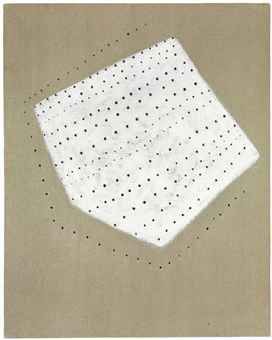Lucio Fontana (1899-1968), Concetto spaziale
Lucio Fontana (1899-1968), Concetto spaziale. photo: Christie's Images Ltd., 2012
signed 'l. fontana' (lower right); signed, titled and dated 'l. fontana concetto spaziale 1954' (on the reverse); pastel and pencil on canvas; 39 3/8 x 31½in. (100.2 x 80cm.). Estimate £400,000 - £600,000
Provenance: Galleria Notizie Arte Contemporanea, Turin.
B. Dalmastro, Turin.
Private Collection, Turin.
Anon. sale, Sotheby's Milan, 26 May 1998, lot 164.
Literature: E. Crispolti, Lucio Fontana: catalogue raisonné des peintures, sculptures et environnements spatiaux, vol. II, Brussels 1974, no. 60 B 20 (illustrated, p. 69).
E. Crispolti, Lucio Fontana: catalogo generale, vol. I, Milan 1986, no. 60 B 20 (illustrated, p. 238).
E. Crispolti, Lucio Fontana: catalogo ragionato di sculture, dipinti, ambientazioni, vol. I, Milan 2006, no. 60 B 20 (illustrated, p. 401).
Exhibited: Turin, Galleria Civica d'Arte Moderna, Lucio Fontana, 1970, no. 91, fig. 87 (illustrated, unpaged).
Verona, Galleria d'Arte Moderna e Contemporanea Palazzo Forti, Lucio Fontana metafore barocche, 2002-2003, no. 18, p. 123 (illustrated in colour, p. 52; dated 1960).
Notes: Dated 1954, Concetto Spaziale is a late example of Lucio Fontana's buchi (hole) series. This was immensely important in the development of the artist's career, as it represented the breakthrough in his unique and instantly recognizable style. The significance of this body of work cannot be overstated, as Fontana himself makes clear, 'my discovery was the hole and that's it. I am happy to go to my grave after such a discovery' (J. Sanna, Lucio Fontana: Materia Spazio Concetto, Milan, 1993, p. 189). This meant that merely puncturing the canvas with a variety of different holes was enough to convey his artistic philosophy.
This is a particularly beautiful example from the series, which is seminal in the development of Fontana's oeuvre towards the slash works which begin to emerge in 1958. The holes are organised according to a rhythmical, elegant order that follows the pentagonal shape of the white pastel on the canvas. The work is characteristic of Fontana's later buchi series in that it is only partially covered by the white pastel, leaving much of the canvas around the edges exposed. The earlier examples from this body of work, begun in 1949, were totally covered in white, and it was only in the later buchi works from 1954 to 1961 that Fontana left the canvas exposed. This means that the holes contrast with the white colouring, leading through to the shadow beyond, and there is a degree of variety in their size and form as Fontana has used more than one tool to create them. Far from being haphazardly punched through, there is a great deal of effort and planning, as he explained 'they think it's easy to make a cut or a hole. But it's not true. You have no idea how much stuff I throw away. The idea has to be realized with precision.' (G. Ballo,Lucio Fontana, New York, 1971, p. 45).
However, they cannot be read merely as graphic elements, but rather are to be understood as physical signs of an opening towards new concepts of space on the traditional surface of the painting. Far from being gashes punched through a canvas, the holes are a way of making the viewer look beyond the physical fact of painting, to what Fontana called a 'free space' that is as much a philosophical concept as a visual one. The space created by the hole stands for the idea of space without physical boundaries, in which the macrocosm of the universe is echoed in the microcosm of the hole.
In this sense, the more Fontana pares down his materials the more he accumulates layers of meaning. By perforating the surface Fontana symbolically introduces a further spatial dimension that is a cosmic allusion. He was particularly interested in science, and the Einsteinian dimension of space/time, once saying: 'Einstein's discovery of the cosmos is the infinite dimension, without end. And here we have the foreground, middleground, background, what do I have to do to go further?...I make a hole, infinity passes through it, light passes through it, there is no need to paint. everyone thought I wanted to destroy: but it is not true. I have constructed.' (C. Lonzi, Autoritratto, (de Donato, Bari, 1969), pp. 170-171). This follows from his desire, expressed in a series of manifestos originating with the Manifest Blanco (White Manifesto) of 1946, for a 'spatialist' art that could engage technology to achieve an expression of the fourth dimension. In this sense, Fontana successfully unites the categories of architecture, sculpture, and painting to create a ground breaking new aesthetic idiom that radically alters viewer's preconceptions about art.
Christies. Post-War and Contemporary Art Day Auction. 15 February 2012. London, King Street www.christies.com

/https%3A%2F%2Fprofilepics.canalblog.com%2Fprofilepics%2F1%2F0%2F100183.jpg)
/https%3A%2F%2Fstorage.canalblog.com%2F03%2F02%2F119589%2F96711876_o.jpg)
/https%3A%2F%2Fstorage.canalblog.com%2F11%2F31%2F119589%2F94773502_o.jpg)
/https%3A%2F%2Fstorage.canalblog.com%2F20%2F83%2F119589%2F94772815_o.jpg)
/https%3A%2F%2Fstorage.canalblog.com%2F26%2F72%2F119589%2F75604929_o.jpg)
/https%3A%2F%2Fstorage.canalblog.com%2F59%2F60%2F119589%2F26458628_o.jpg)



/image%2F1371349%2F20240313%2Fob_3da818_431115881-1632814154155264-57534444325.jpg)
/image%2F1371349%2F20240312%2Fob_cc9c83_f2.jpg)
/image%2F1371349%2F20240311%2Fob_2edda2_fontana.jpg)
/http%3A%2F%2Fstorage.canalblog.com%2F86%2F67%2F119589%2F129815803_o.png)